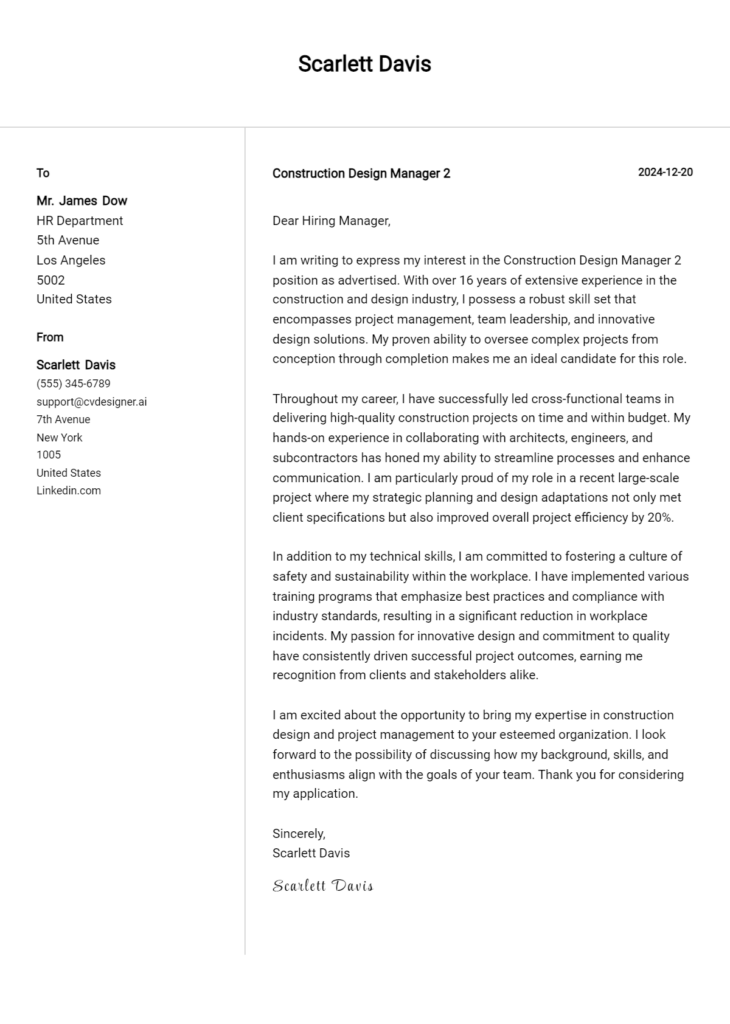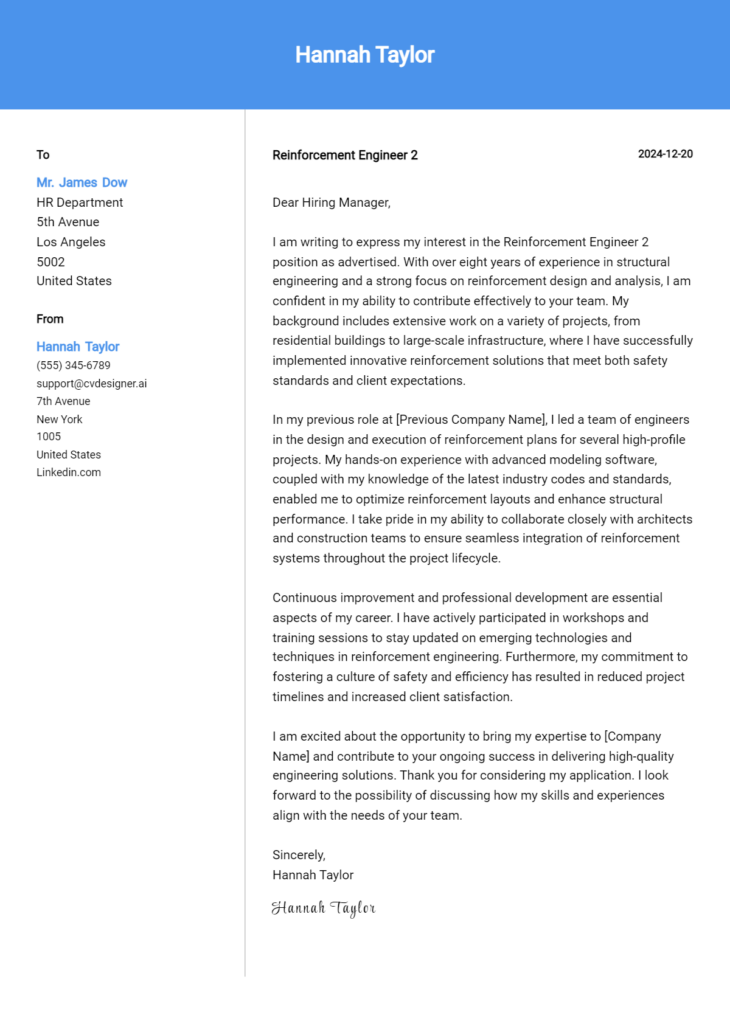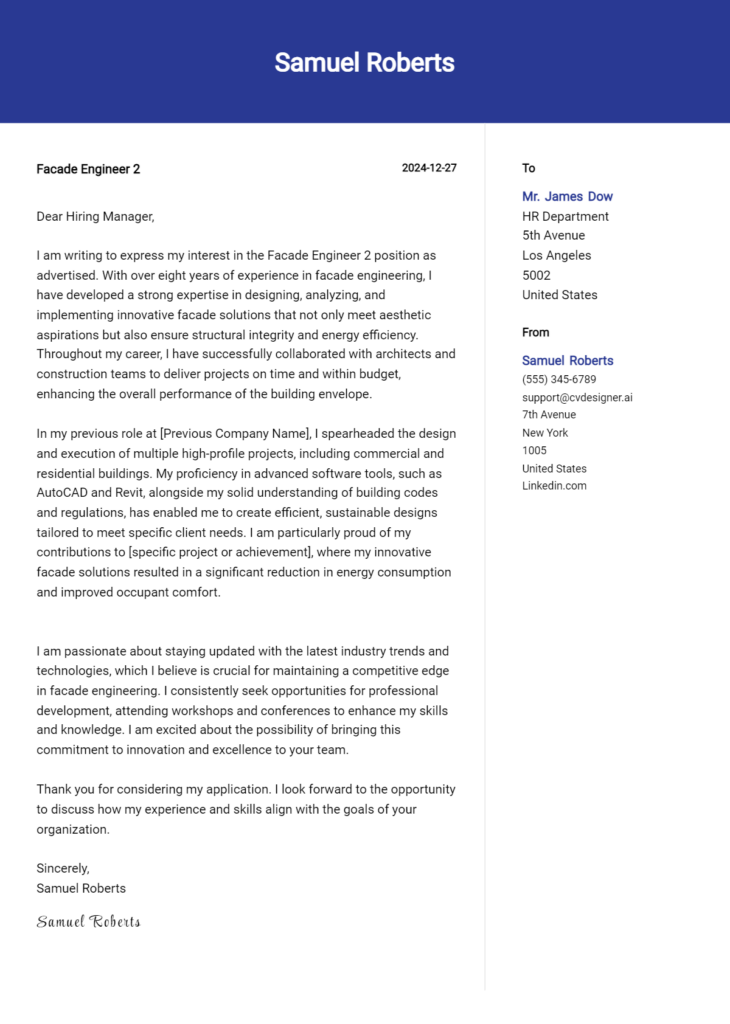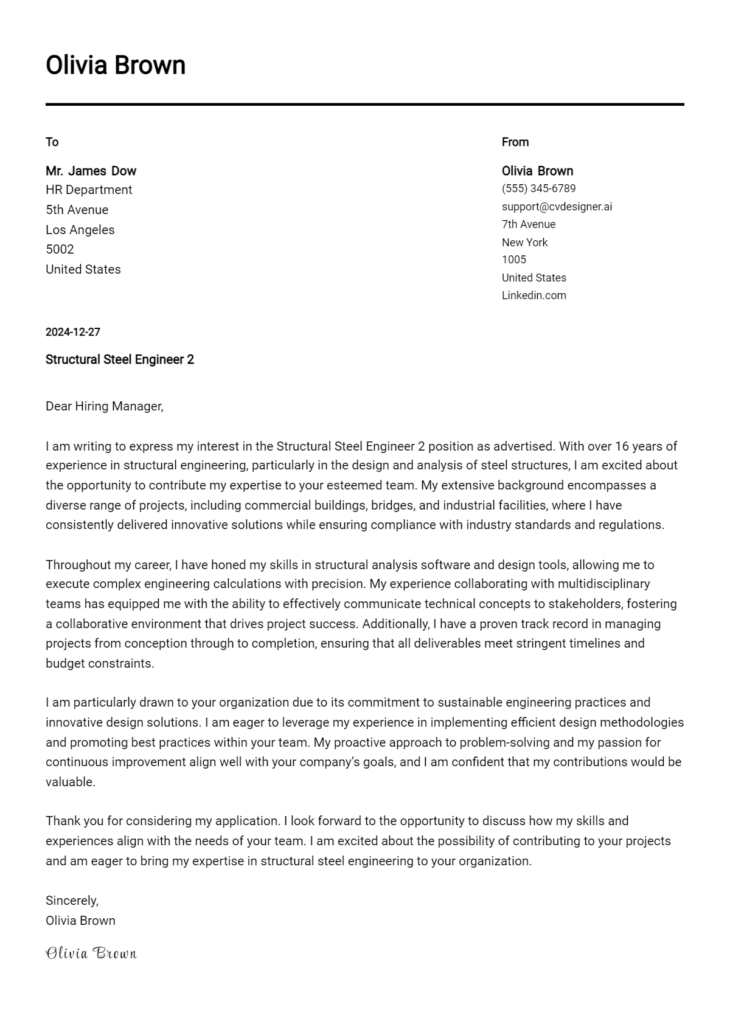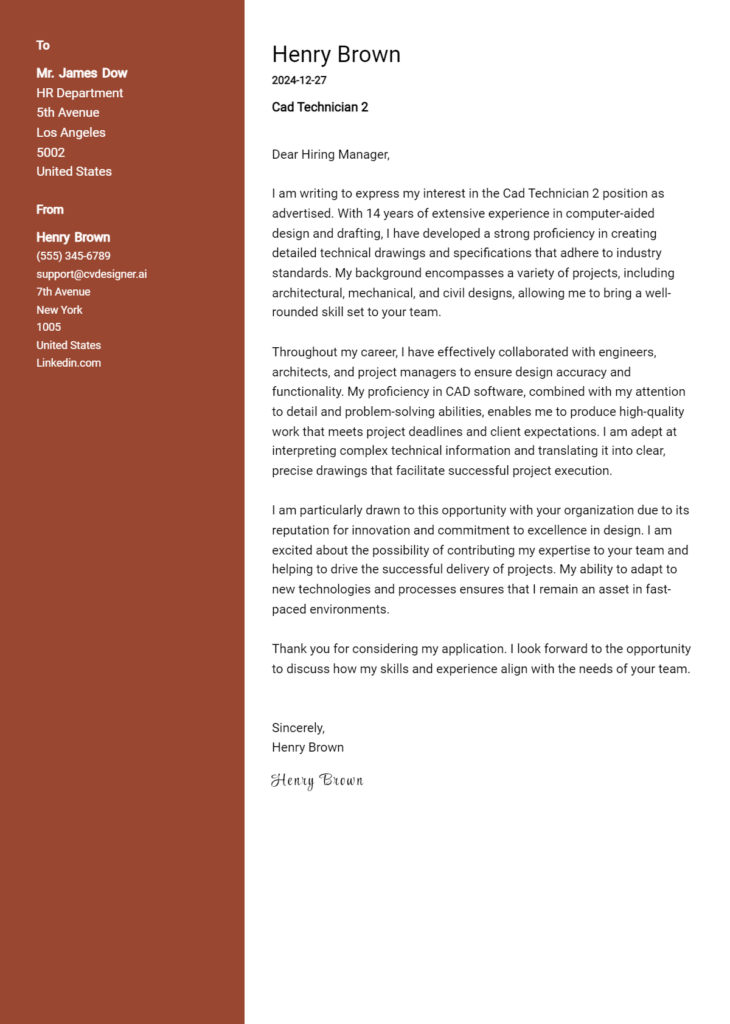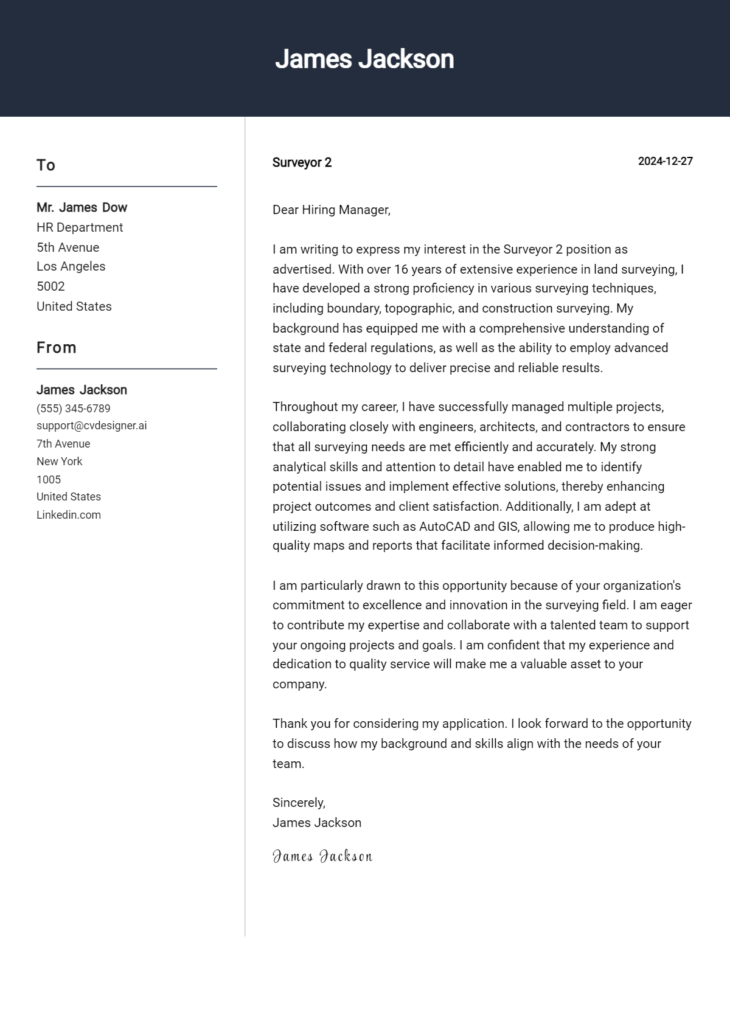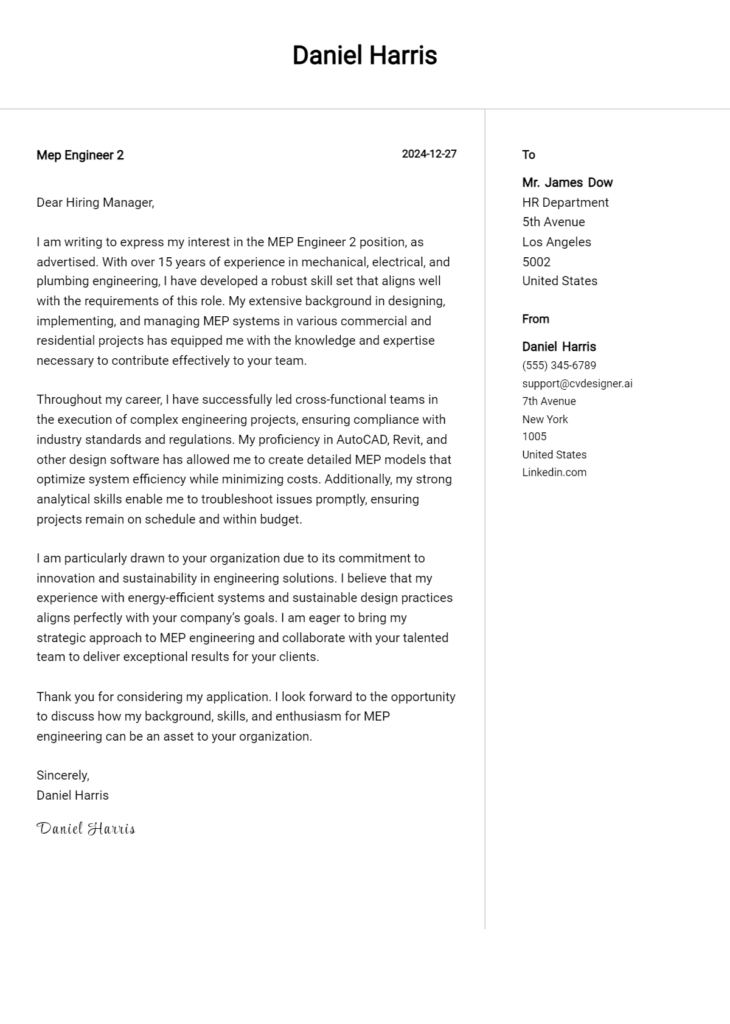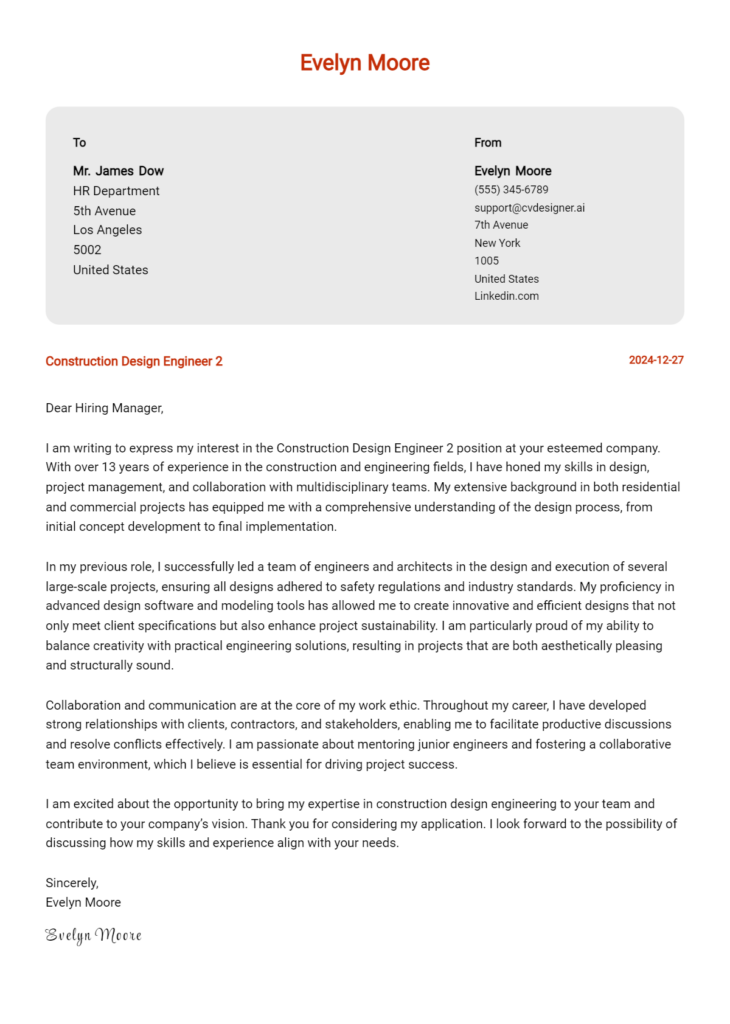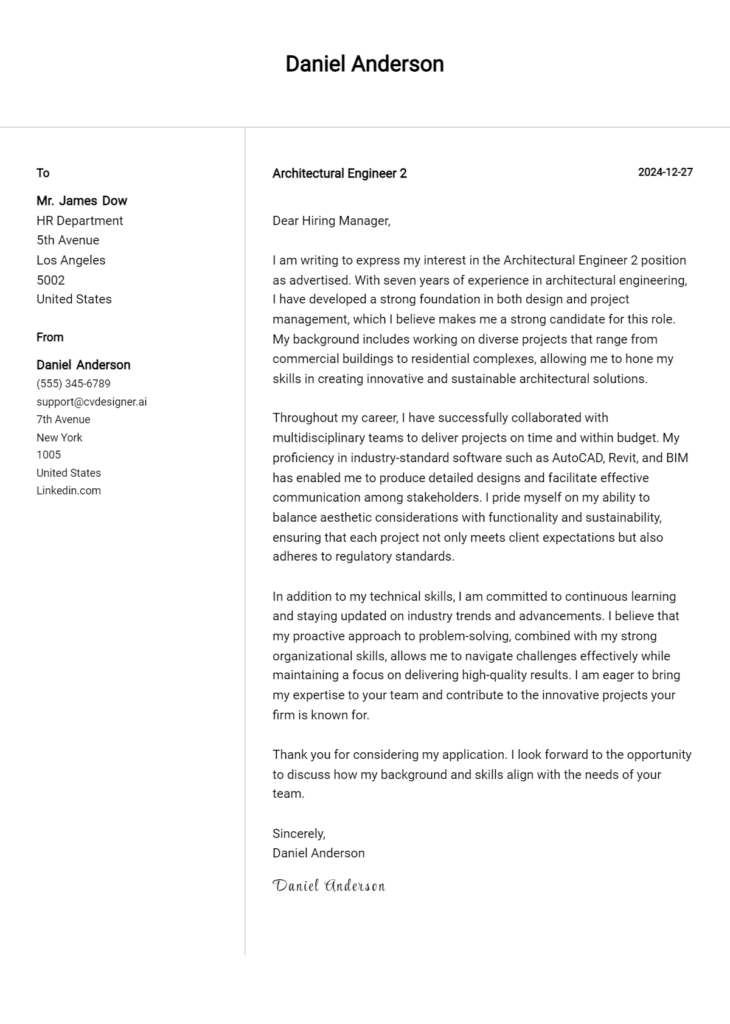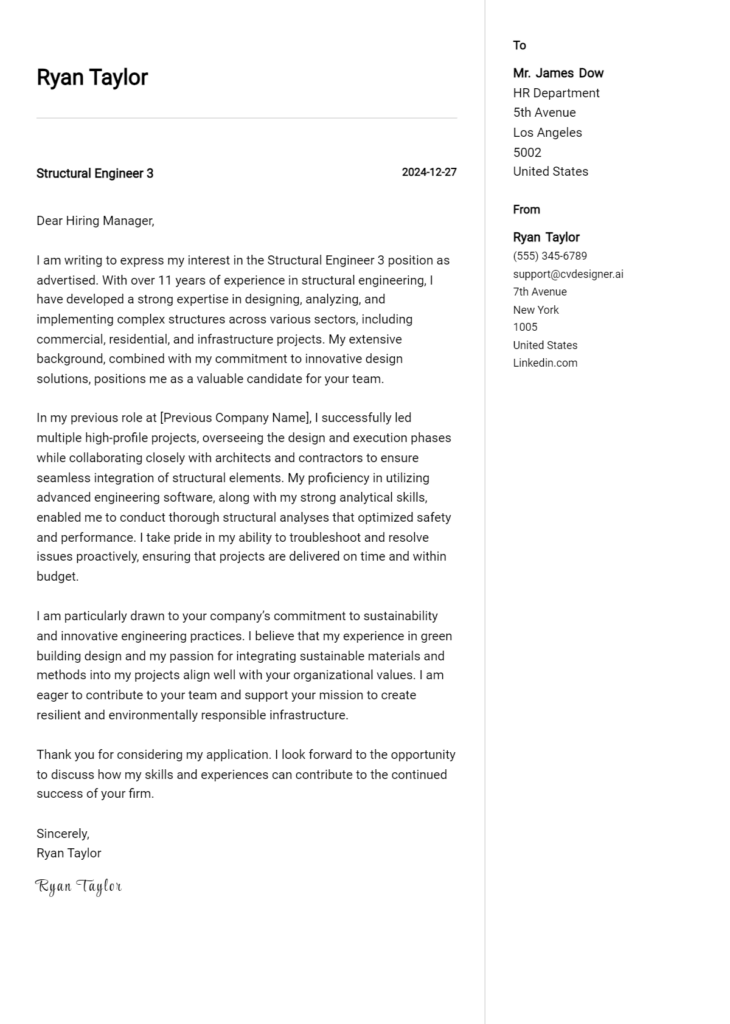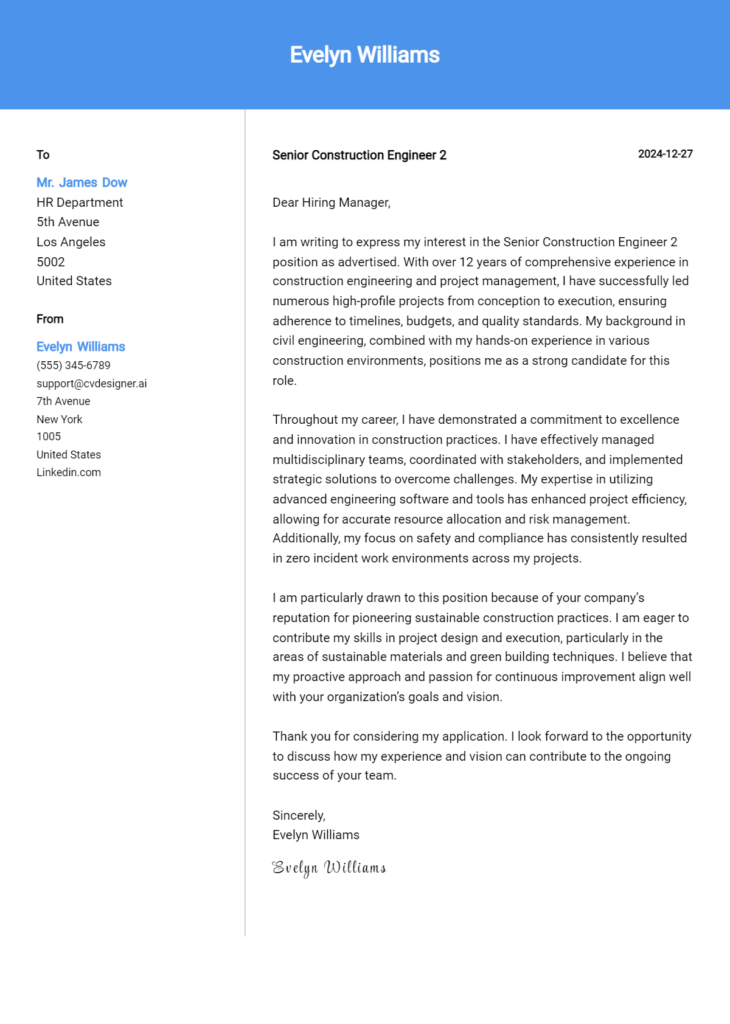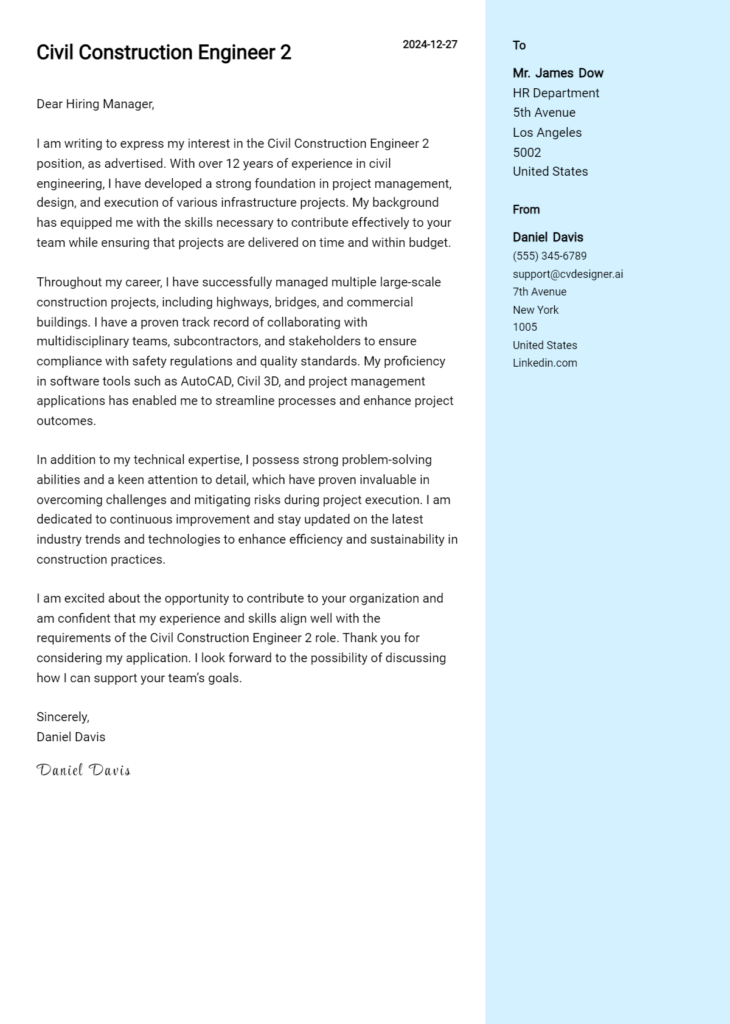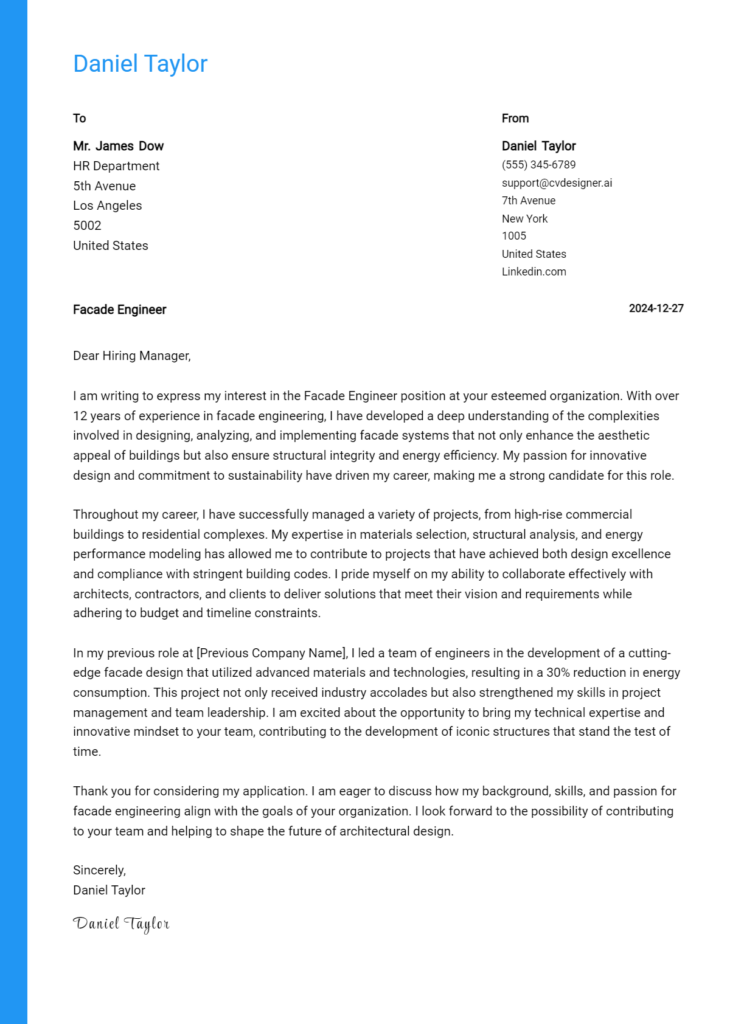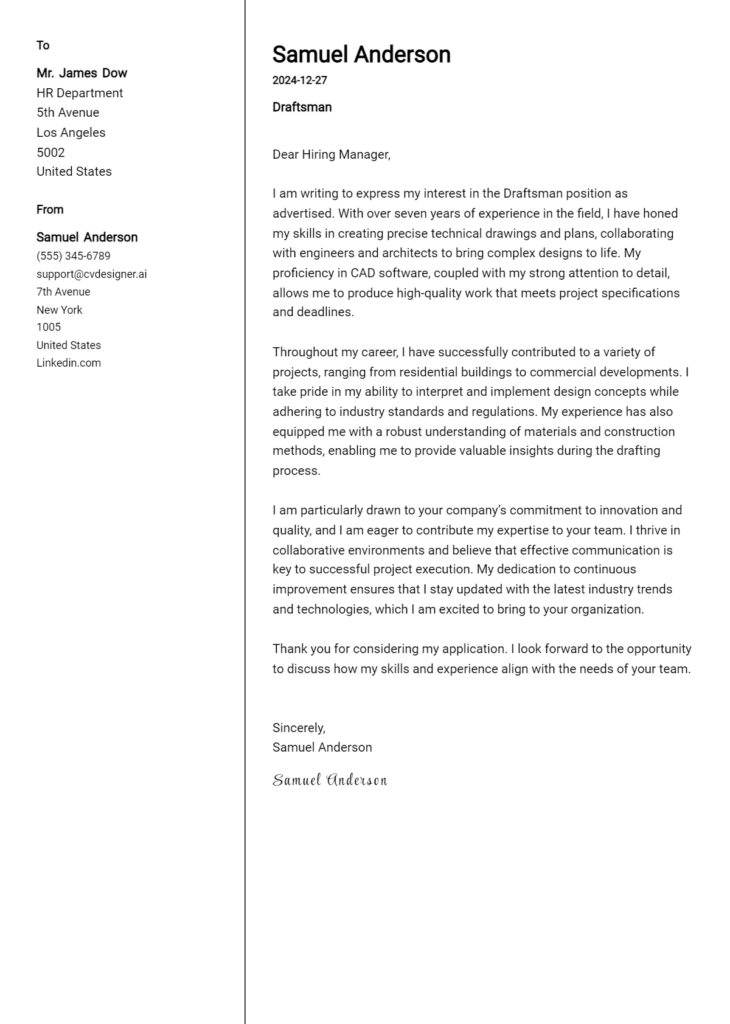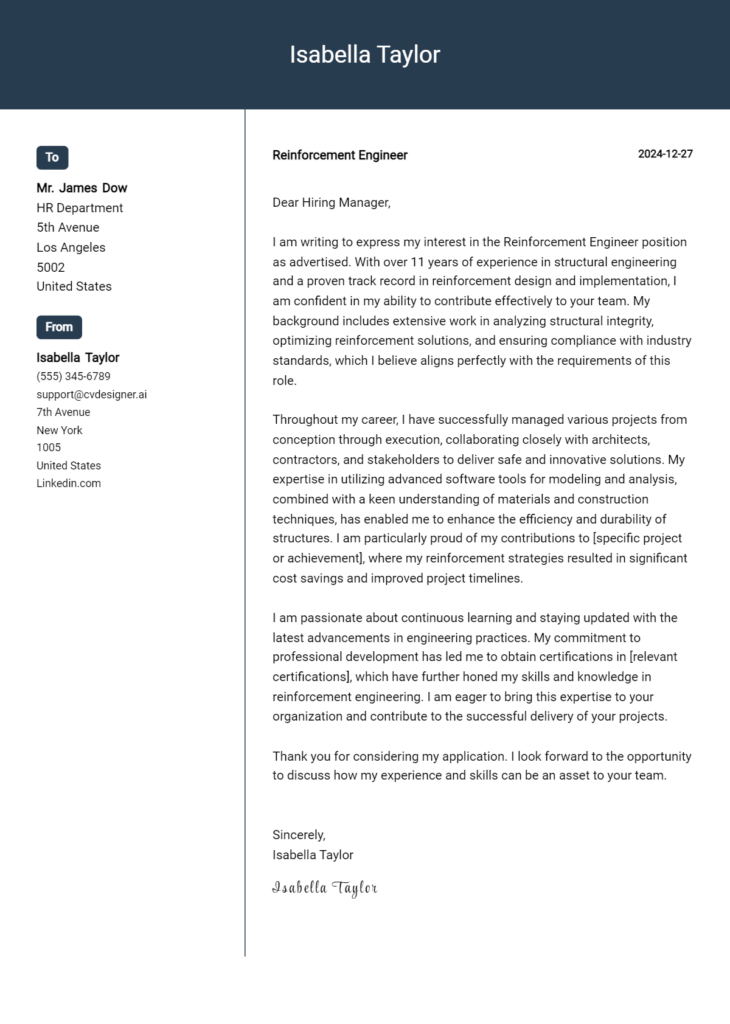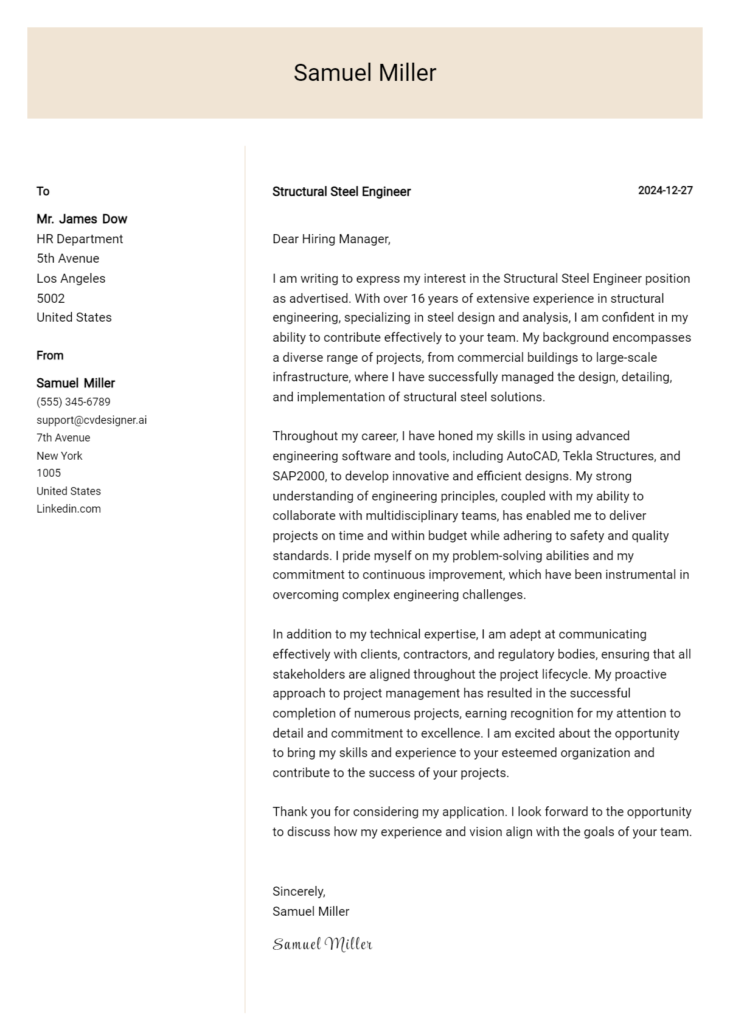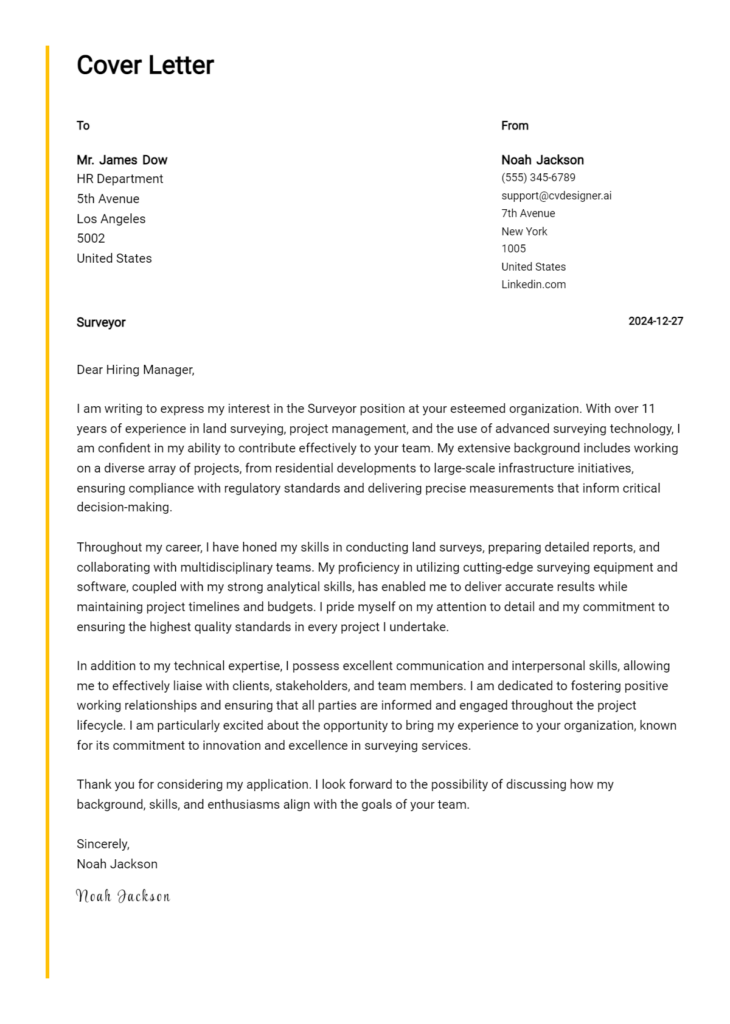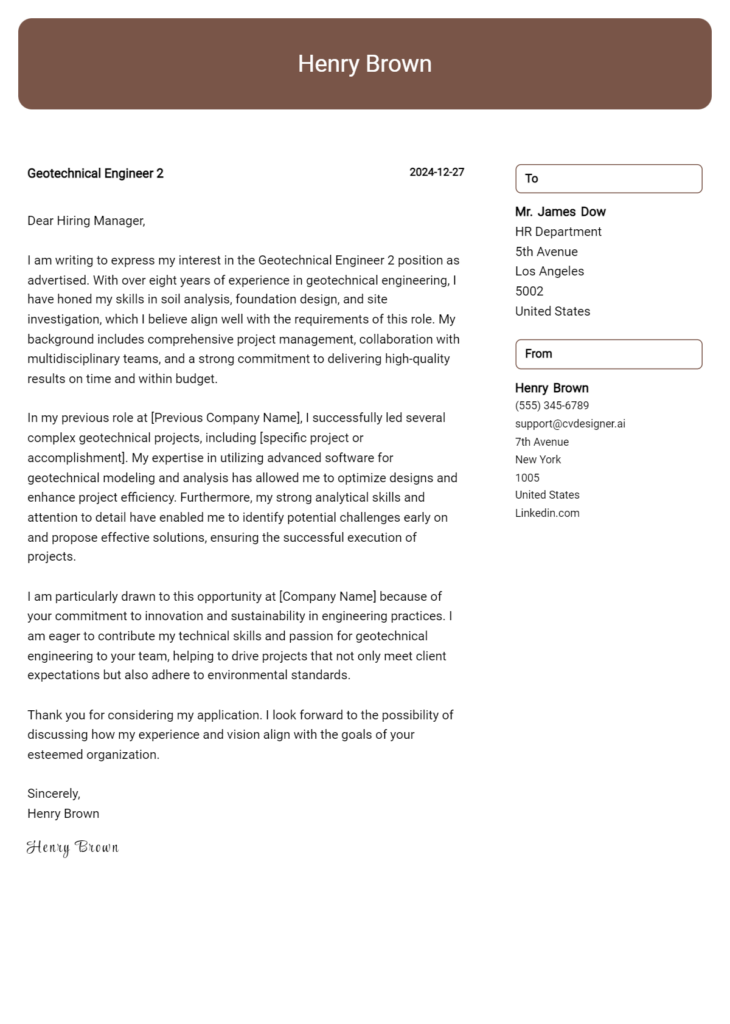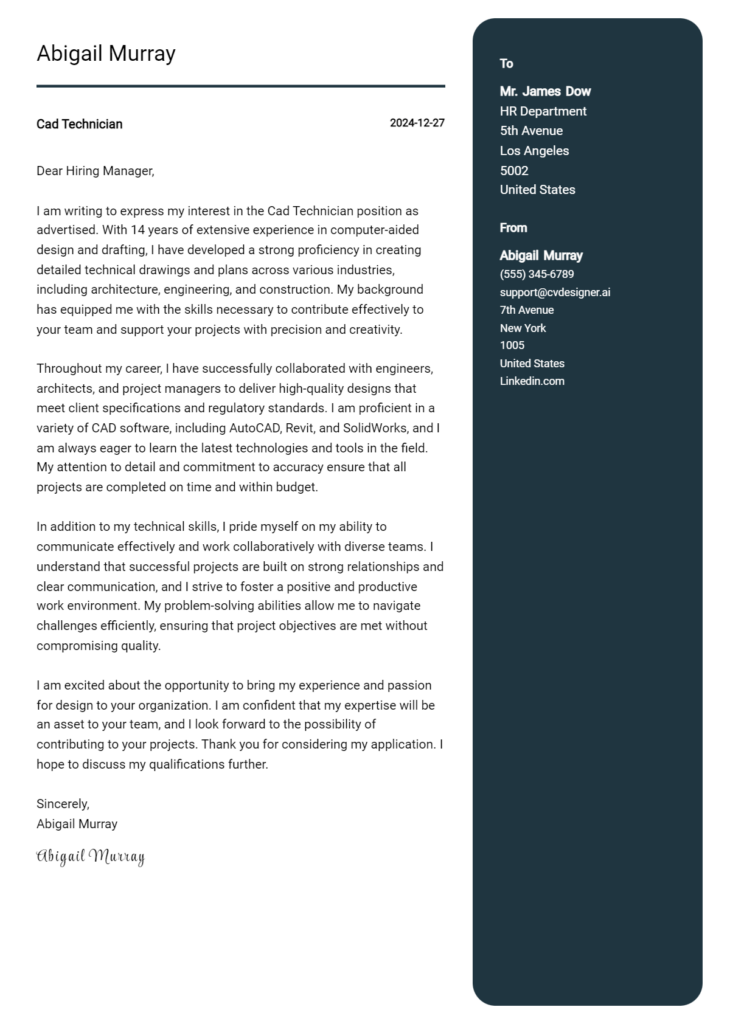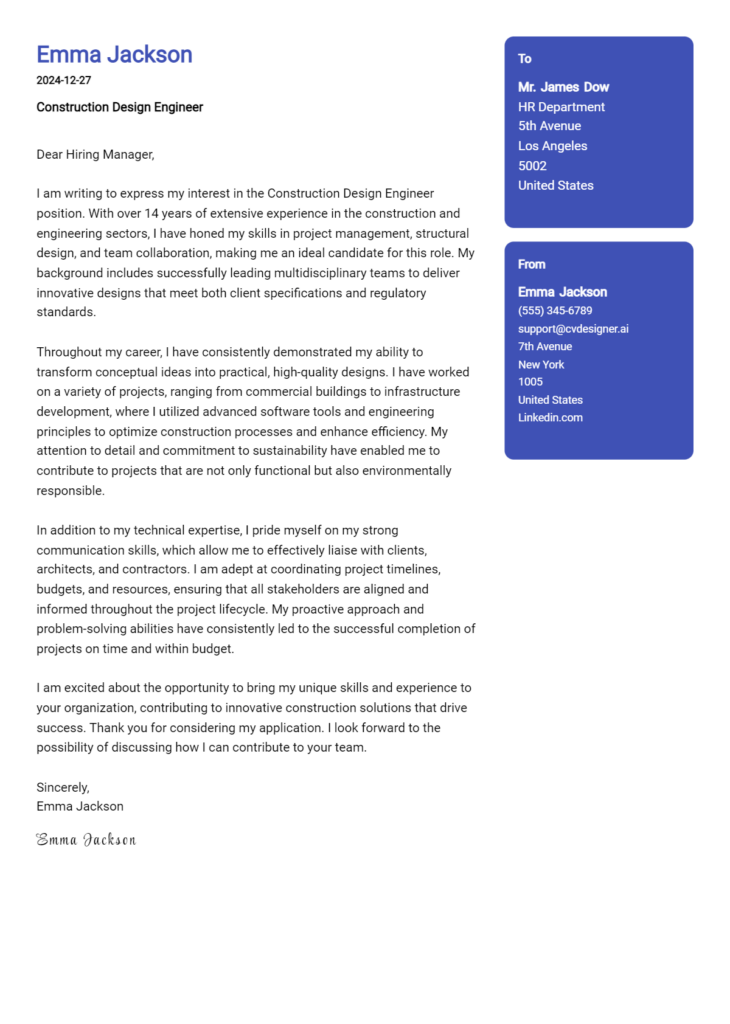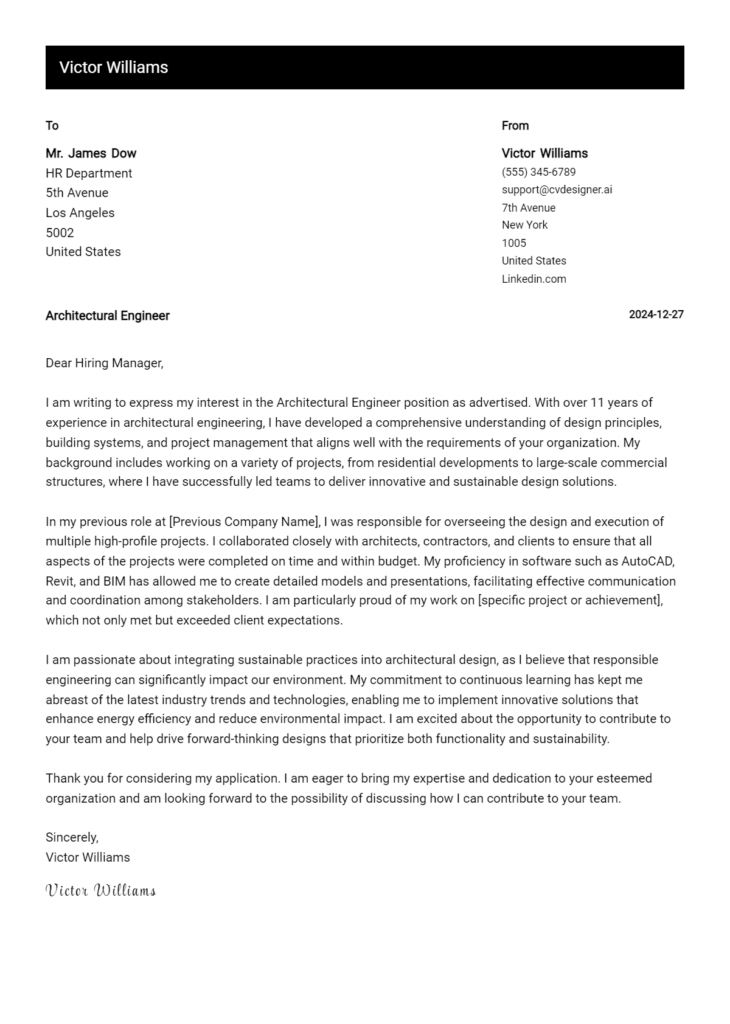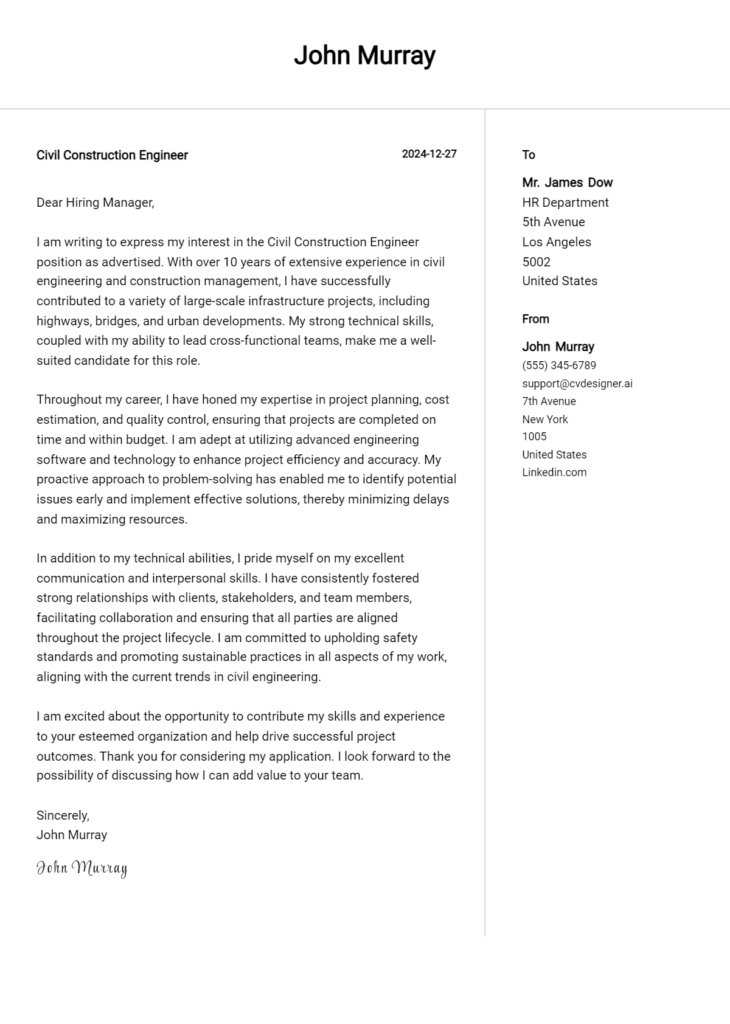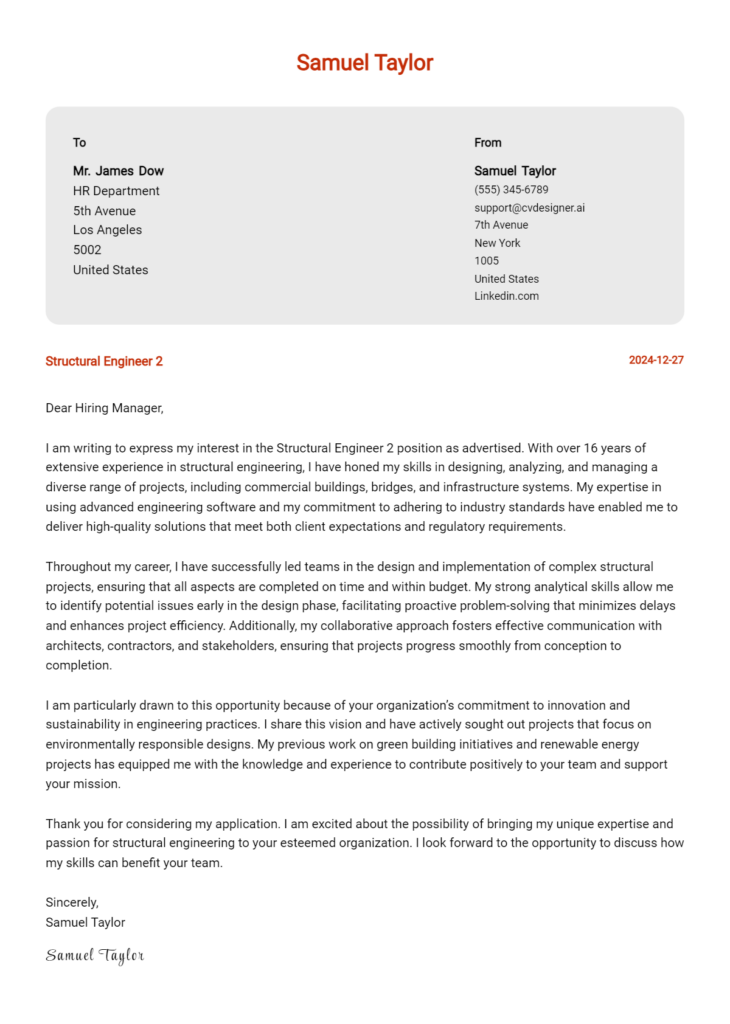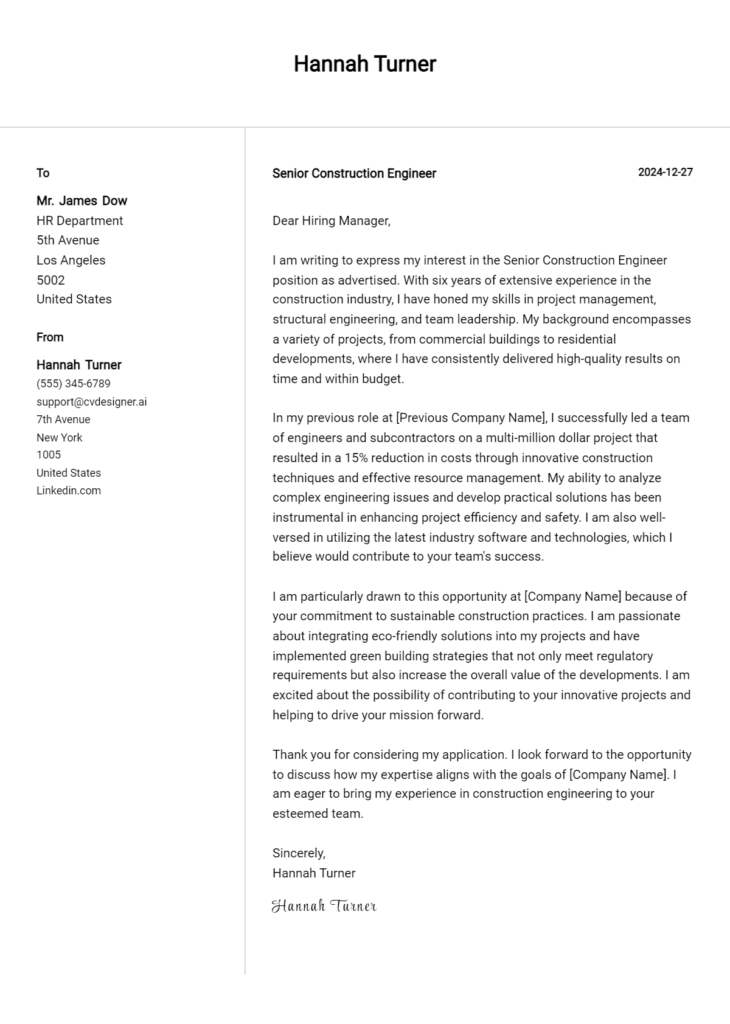Draftsman 2 Cover Letter Examples
Explore additional Draftsman 2 cover letter samples and guides and see what works for your level of experience or role.
How to Format a Draftsman Cover Letter?
Crafting a compelling cover letter is essential for a Draftsman, as it serves as your first opportunity to showcase your design skills and attention to detail. Effective formatting not only highlights your qualifications but also reflects your ability to present information clearly and concisely—traits that are crucial in the drafting profession. A well-structured cover letter can capture the hiring manager's attention and demonstrate your professionalism and commitment to high-quality work.
In this guide, we will explore how to structure your cover letter, providing insights and draftsman-specific examples to help you create an impressive document.
We will focus on the essential components of a professional cover letter, including:
- Cover Letter Header
- Cover Letter Greeting
- Cover Letter Introduction
- Cover Letter Body
- Cover Letter Closing
Each section is vital for showcasing your skills and suitability for the role. Let’s break down each part and discuss how to make your Draftsman cover letter stand out.
Importance of the Cover Letter Header for a Draftsman
The cover letter header is crucial for a Draftsman as it sets the tone for the entire document and provides essential information at a glance. A well-structured header not only conveys professionalism but also ensures clarity, making it easy for potential employers to identify the applicant and the context of the correspondence. It should typically include the applicant's contact information, the date, and the recipient's details. Ensuring all this information is presented clearly helps to create a positive first impression.
Strong Example
John Doe 123 Design Avenue City, State, Zip john.doe@email.com (123) 456-7890 October 1, 2023 Mr. Smith Hiring Manager ABC Engineering Firm 456 Industry Road City, State, Zip
Weak Example
j.doe@email.com 123 Avenue 10/1/23 To Whom It May Concern
The Importance of the Cover Letter Greeting
The greeting of your cover letter plays a crucial role in setting the tone for the rest of your application. A well-crafted greeting not only establishes a professional demeanor but also adds a personal touch by addressing the hiring manager directly. This personalization can create a positive first impression, signaling your genuine interest in the position. To achieve this, it's essential to avoid generic greetings such as "To Whom It May Concern." Instead, take the time to research the recipient's name and title, which demonstrates diligence and respect for the person you are addressing.
Here are some examples of strong and weak greetings for a Draftsman cover letter:
Strong Greeting Example
Dear Mr. Johnson,
Weak Greeting Example
To Whom It May Concern,
The Importance of a Strong Cover Letter Introduction for a Draftsman
A well-crafted cover letter introduction is crucial for a Draftsman as it serves as the first impression for the hiring manager. This opening paragraph should capture their attention and express the candidate's genuine interest in the role. By briefly showcasing relevant skills or achievements, the introduction sets the tone for the rest of the cover letter and highlights the candidate’s qualifications. An engaging introduction not only piques interest but also encourages the hiring manager to read further, ultimately increasing the chances of landing an interview.
Strong Example
Dear [Hiring Manager’s Name], As a highly skilled Draftsman with over five years of experience in creating precise technical drawings and plans, I was thrilled to discover the Draftsman position at [Company Name]. My passion for design and my proficiency in AutoCAD and Revit have enabled me to contribute to numerous successful projects, including the award-winning [Project Name]. I am eager to bring my expertise and creative vision to your esteemed team.
Weak Example
To Whom It May Concern, I am writing to apply for the Draftsman position. I have some experience with drafting and think I could be a good fit for the job. I can use a few drafting programs, but I’m still learning.
Purpose of the Cover Letter Body for a Draftsman
The cover letter body for a Draftsman serves as a critical opportunity to articulate the candidate's unique skills, experiences, and the value they can bring to the company. It allows the applicant to highlight specific projects or accomplishments that demonstrate their technical proficiency and attention to detail. For instance, mentioning a successful collaboration on a large-scale architectural project can illustrate not only technical abilities but also teamwork and communication skills. This section should create a compelling narrative that aligns the candidate's qualifications with the needs of the employer, ultimately persuading them to consider the applicant for the role.
Strong Example
I am excited to apply for the Draftsman position at ABC Construction. With over five years of experience in creating detailed architectural plans, I have successfully contributed to projects such as the XYZ Office Complex, where my precise drafting skills helped reduce construction time by 15%. My proficiency in AutoCAD and Revit, combined with my strong understanding of building codes and regulations, ensures that my designs are both innovative and compliant. I am particularly proud of my role in the redevelopment of the downtown park, which involved close collaboration with multiple stakeholders to create a sustainable and aesthetically pleasing environment. I am eager to bring my expertise in drafting and project management to your team.
Weak Example
I am writing to apply for the Draftsman job. I have done some drafting work before and I think I can do a good job. I like to work on different projects. I have used AutoCAD a bit but I haven’t done anything major. I am looking for a job where I can learn more and grow my skills. I hope you consider me for the position.
The Importance of a Cover Letter Closing for a Draftsman
The closing paragraph of a cover letter is crucial for a Draftsman as it serves to summarize qualifications, reinforce enthusiasm for the position, and prompt the hiring manager to take the next steps. A strong closing effectively ties together the candidate's skills and experiences while expressing a genuine interest in contributing to the organization. Conversely, a weak closing can leave a lackluster impression, failing to convey motivation or suggest future action.
Strong Example
Thank you for considering my application for the Draftsman position. With my proficiency in AutoCAD and a proven track record of delivering high-quality design solutions, I am excited about the opportunity to contribute to your team. I look forward to the possibility of discussing how my skills can benefit your projects. Please feel free to review my resume and contact me to schedule an interview at your convenience.
Weak Example
I hope you like my application. I am looking for a job, and I think I could do it well. Please call me if you want to talk.
Crafting an effective cover letter is essential for any Draftsman looking to secure a position in a competitive job market. A well-written cover letter not only highlights your qualifications but also conveys your enthusiasm and fit for the role. In your cover letter, it’s important to showcase your technical skills, problem-solving abilities, knowledge of the software development lifecycle (SDLC), teamwork experience, and a commitment to continuous learning. Below are five detailed tips to help you create a compelling cover letter that stands out.
Tips for Writing a Draftsman Cover Letter
Highlight Your Technical Skills: Clearly articulate the technical skills that are relevant to the Draftsman role. Mention specific software you are proficient in, such as AutoCAD, Revit, or SolidWorks. Providing examples of projects where you utilized these skills can demonstrate your expertise and make your application more persuasive.
Showcase Problem-Solving Abilities: Employers value candidates who can think critically and solve problems effectively. Include a brief anecdote about a challenging project you worked on, detailing how you identified the issue and implemented a solution. This not only showcases your problem-solving skills but also your ability to work under pressure.
Demonstrate Knowledge of the SDLC: Understanding the software development lifecycle is crucial for a Draftsman, especially when collaborating with engineers and developers. Discuss your familiarity with different phases of the SDLC and how you have contributed to projects at various stages, emphasizing your versatility and adaptability.
Emphasize Teamwork Experience: In many drafting roles, collaboration with other professionals is key. Highlight your experience working in teams, mentioning specific projects where you contributed to group success. Discuss how your communication skills and ability to share ideas fostered a positive working environment.
Express a Passion for Continuous Learning: The drafting and design industry is constantly evolving with new technologies and methodologies. Share your commitment to professional development by mentioning any courses, workshops, or certifications you’ve pursued. This shows prospective employers that you are proactive about enhancing your skills and staying current in the field.
By following these tips, you can create a standout cover letter that effectively showcases your qualifications as a Draftsman. For additional resources, you may want to explore cover letter templates or utilize a cover letter builder to help streamline your writing process.
Common Mistakes to Avoid in a Draftsman Cover Letter
Crafting an effective cover letter is essential for standing out in a competitive job market, especially for a role as detail-oriented as a Draftsman. Avoiding common mistakes can significantly enhance your chances of making a positive impression on potential employers. Here are some frequent pitfalls to watch out for:
Generic Salutations: Addressing your letter to "To Whom It May Concern" can come off as impersonal. Always try to find the hiring manager's name for a more personal touch.
Lack of Specificity: Failing to tailor your letter to the specific job role can make it seem like a template. Reference the specific skills and experiences that match the job description.
Overly Technical Language: While showcasing your technical skills is important, using overly complex jargon can alienate the reader. Aim for clarity and simplicity.
Ignoring Formatting Guidelines: A cluttered or unprofessional format can detract from your message. Refer to cover letter format guidelines to present a clean and organized document.
Focusing Solely on Qualifications: While it’s important to mention your qualifications, also convey your enthusiasm for the role and the company. Engage the reader with your passion for the field.
Neglecting Proofreading: Spelling and grammatical errors can undermine your professionalism. Always proofread your letter or have someone else review it before submission.
Not Including Relevant Examples: Failing to provide specific examples of past projects or achievements may leave your qualifications feeling vague. Reference your portfolio or notable work to reinforce your skills.
By steering clear of these common mistakes, you can create a compelling cover letter that effectively showcases your capabilities as a Draftsman. For additional inspiration, check out various cover letter examples to help guide your writing process.
Cover Letter FAQs for Draftsman
What should I include in my cover letter as a Draftsman?
In your cover letter, it’s essential to highlight your technical skills, relevant experience, and familiarity with industry-standard software and tools, such as AutoCAD or Revit. Start by introducing yourself and stating the position you’re applying for. Then, discuss your educational background, emphasizing any degrees or certifications related to drafting. Provide specific examples of past projects where you effectively applied your drafting skills, showcasing your ability to interpret blueprints and collaborate with engineers and architects. Finally, express your enthusiasm for the role and how your skills align with the company’s objectives.
How do I tailor my cover letter for a specific job?
To tailor your cover letter for a specific job, carefully read the job description and identify key qualifications and responsibilities. Use this information to customize your cover letter. Begin by addressing the hiring manager by name if possible. In the body, mention specific skills or experiences that directly relate to the job requirements. For instance, if the role emphasizes experience in commercial drafting, highlight relevant projects you’ve completed. Tailoring your cover letter shows the employer that you’ve done your research and are genuinely interested in their company and the position.
How long should my cover letter be?
Your cover letter should ideally be one page long, consisting of three to four paragraphs. This length allows you to convey your qualifications and experiences without overwhelming the reader. Aim for approximately 250 to 400 words. Start with a brief introduction, followed by a paragraph detailing your relevant experience and skills. Use the next paragraph to provide examples of past work or projects that demonstrate your capabilities. Finally, conclude with a strong closing statement expressing your enthusiasm for the role and your desire for an interview. A concise, focused cover letter will make a stronger impact.
Should I mention my portfolio in my cover letter?
Absolutely! Mentioning your portfolio in your cover letter is highly beneficial as it provides tangible proof of your skills and accomplishments. In your letter, you can briefly describe the types of projects included in your portfolio and how they relate to the position you’re applying for. Make sure to include a link or indicate that your portfolio is attached for the employer’s review. This not only showcases your work but also reinforces your qualifications and demonstrates your proactive approach. A well-presented portfolio can significantly increase your chances of securing an interview.
Build your Cover Letter in minutes
Use an AI-powered cover letter builder and have your letter done in 5 minutes. Just select your template and our software will guide you through the process.


